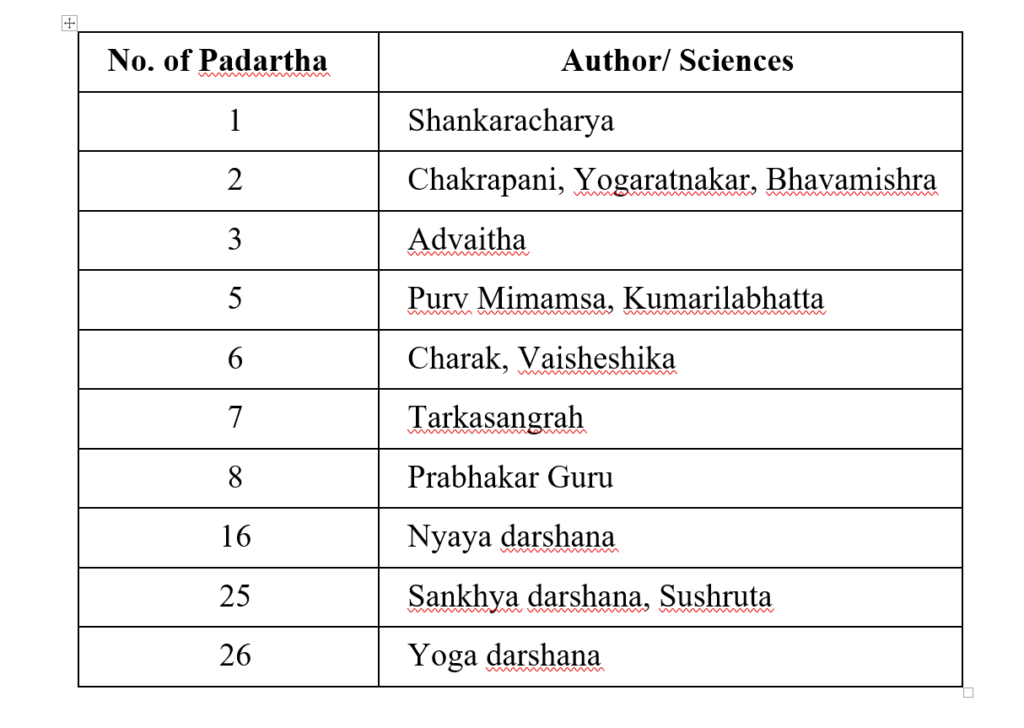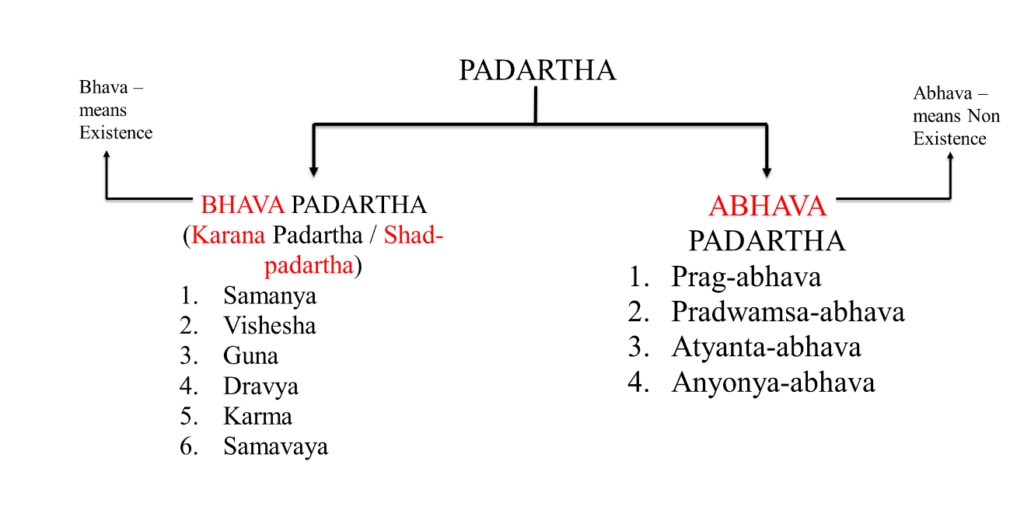Padartha
The term Padartha is derived from the Sanskrit word Pada, meaning “to go” or “to move.”
When combined with Artha, which refers to “meaning” or “significance,” the word Padartha denotes the “meaning or significance of a word or concept.” Thus, Padartha refers to the essence or substance of a word, formed by the union of Pada (word) and Artha (meaning).
Definition of Pada –
शक्तं पदम्। (which is endowed with special power)
सुप्तिङ्न्तम् पदम्। (words ending with Supa)
Definition of Padartha –
· पदस्य अर्थः पदार्थः । (च.सि.१२)
The knowledge or meaning of Pada is known as Padartha.
· पदस्य पदयोः पदानां वाऽर्थः पदार्थः । (सु.उ.६५)
The meaning which is exhibited while pronouncing the word is called as Padartha
· प्रमितिविषयाः पदार्थः ।
The knowable things can be termed as Padartha
· पद्यते गम्यते येन अर्थ स पदार्थः ।
The artha jnana of Pada is Padartha.
Padartha Lakshana –
अस्तित्वं अभिधेयत्वं प्रमेयत्वं वा पदार्थ सामान्य लक्षणम् । -(तर्कसंग्रह)
1. Astitwam – existence
2. Abhidheyatwam – namability
3. Prameyatwam – knowability
Need of studying Padartha Vijnanam –
- Each branch of science has its own set of padarthas—specialized terminology that is unique to that field. To gain a deeper understanding of any science, it is essential to familiarize oneself with these technical terms.
In order to study Ayurveda effectively, one must first comprehend its philosophical foundations and become familiar with the scientific terms specific to Ayurvedic practice. Therefore, understanding Padartha-Vyutpatti (the origin and meaning of terms) is crucial for a thorough understanding of Ayurveda.
Number of Padartha acco. to different sciences –

Classification of Padartha –

Padartha as per Charak Samhita (Ayurveda) –
Shad-Karana (Karana Padartha) :
सामान्यं च विशेषं च गुणान् द्रव्याणि कर्म च ॥
समवायं च तद् ज्ञात्वा तन्त्रोक्तं विधिमास्थिताः । (Ch.Su.1)
1. Samanya
2. Vishesha
3. Guna
4. Dravya
5. Karma
6. Samavaya
Padartha as per Chakrapani –
1. Sata (Bhava)
2. Asata (Abhava)
Padartha as per Nyaya Darshana –
- Pramana
- Prameya
- Samshaya
- Prayojana
- Drushtanta
- Siddhanta
- Avayava
- Tarka
- Nirnaya
- Vada
- Jalpa
- Vitanda
- Hetwabhasa
- Jati
- Chhala
- Nigrahasthana
Padartha as per Sankhya Darshana –
Mula Prakruti
Purusha
Mahat (Buddhi)
Ahankar
11-Indriyas
5-Tanmatra
5-Mahabhuta
Padartha as per Yoga Darshana –
Mula Prakruti
Purusha
Mahat (Buddhi)
Ahankar
11-Indriyas
5-Tanmatra
5-Mahabhuta
Ishwara
Padartha as per Yoga Darshana –
Mula Prakruti
Purusha
Mahat (Buddhi)
Ahankar
11-Indriyas
5-Tanmatra
5-Mahabhuta
Ishwara
Sadharmya of Padartha (Similarities) –
All Padarthas share three fundamental characteristics (Lakshanas):
- Astitwa (Existence)
- Abhidheyatwa (The ability to be named or described)
- Prameyatwa (The capacity to be measured or perceived).
Dravya, Guna, Karma, Samanya, and Vishesha all inherently possess two qualities:
- Samavayitwa (Inherence, meaning they are closely connected)
- Anekatwa (Multiplicity or diversity, indicating they can have many forms).
Guna, Karma, Samanya, Vishesha, and Samavaya all exhibit two other qualities:
- Nirgunatwa (Absence of qualities or attributes)
- Nishkriyatwa (Absence of activity or action).
Samanyatwa (Universality), Visheshatwa (Particularity), and Karanatwa (Causality) are present in Dravya, Guna, and Karma.
Padartha serves as the Karana (cause) for Dravya, Guna, and Karma.
Swatah Sata (Self-existence), Buddhi-lakshanatwa (Character determined by intellect), Akaranatwa (Lack of action), Akaryatwa (Non-effectiveness), and Nityatwa (Eternal nature) are equally found in Samanya (Universality) and Samavaya (Inherence).
Vaidharmya of Padartha (Dissimilarities) –
Guna and Karma can have their support or substratum (Ashraya) in Dravya, but Dravya cannot have its support in Guna or Karma.
Vaidharmya (diversity) in categories – Samanya has three types, while there are 41 different types of Guna.
All Padarthas have various categories or types, except for Samavaya.
Samanya is the factor that brings things together or aggregates them, while Vishesha is the factor that separates or distinguishes.
Guna and Karma reside only in Dravya. Guna is characterized by Nishcheshta (absence of activity or motion), while Karma is characterized by Cheshtayukta (being associated with action or movement).
Importance of Padartha Vijnanam in Ayurveda –
- To achieve the goals and objectives of Ayurveda.
- To understand the fundamental principles of Ayurveda through the study of Padartha Vijnanam.
- It provides comprehensive knowledge about Dravya (substances) and the Five Mahabhutas (elements).
- To maintain Dhatu-Satmya (the harmony of tissues), understanding the related basic elements (Pancha Mahabhuta) is essential.
- Some core principles of Ayurveda are derived from Indian philosophy, particularly from Darshana Shastra.
- It is important to grasp the basic rules and guidelines to attain the fourfold human goals (Chaturvidha Purushartha).
- To reach the ultimate goal of Moksha (salvation), one must follow the procedures outlined in Padartha Vijnanam.
- To understand the basic composition of various factors and their structure in relation to the Pancha Mahabhutas.
- For example: Vata = Vayu + Akash,
Madhura = Prithvi + Jala. - To gain insight into the creation of the world (Srushti Utpatti).
- To clarify doubts about concepts like God, Fate, Birth, Rebirth, the Soul-Mind connection, and Moksha.
- To acquire in-depth knowledge of Darshana (philosophy), the relationship between cause and effect (Karana-Karya), Dravya, the Seven Padarthas, the Self (Atma), various philosophical theories, and their validation through different Pramana (means of knowledge).
- Padartha Vijnanam serves as the foundational science.
- It is essential for expanding knowledge and conducting research.
- Padartha Vijnanam is the key to understanding the hidden aspects of the body (Sharira) and the universe (Srushti), such as the subtle body (Sukshma Sharira), the individual soul (Jivatma), and the Supreme Soul (Paramatma).
- It provides guidance not only to relieve suffering (Dukkha) but also to attain ultimate happiness and liberation (Moksha).

